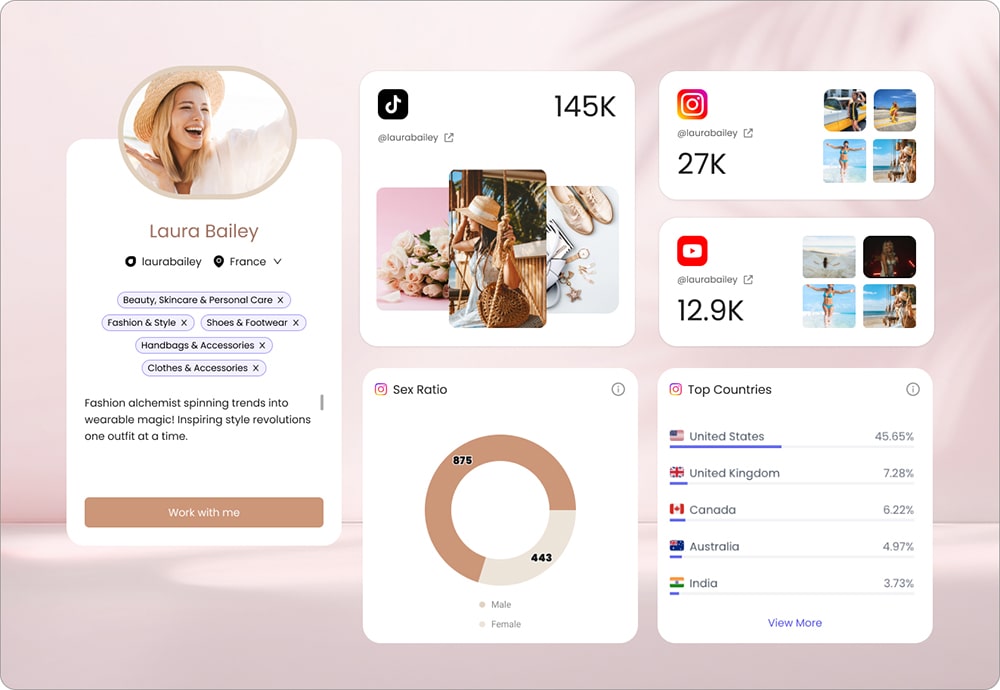- Who Are Macro Influencers?
- Importance of Macro Influencers in Influencer Marketing Campaigns
- Why Work With Macro-Influencers?
- Overview of the Typical Characteristics of Macro-Influencers
- Macro-Influencer Collaboration Examples
- Micro vs. Macro vs. Mega Influencers
- Micro-influencers vs. Macro-influencers
- Mega-influencers vs. Macro-Influencers
- Working With Macro Influencers: The Drawbacks
- Brand and Macro-Influencer Partnership Strategies
- FAQ
- Conclusion
Gaining the trust of today’s consumers is not easy. It requires more than just being seen: you need to be able to find them in the places they hang out and reach them through the voices and mediums that they trust. To achieve that, over the last few years, macro-influencers have been a great help to brands. In fact, if used correctly, collaboration with macro-influencers can be gold mines for businesses.
This article sheds light on who macro-influencers are, why you should consider working with them, and what steps you need to take to ensure a successful collaboration.
Who Are Macro Influencers?
Macro influencers are social media creators who have between 50,000 and 500,000 followers. Although still far from celebrity status, they are some of the most powerful people in the online world. Macro influencers can be both social media creators as well as famous people from various industries who grew their following through work outside of social platforms.
Compared to their smaller counterparts, macro-influencers have lower engagement rates, but are connected to a significantly larger number of people and have a much wider reach. Also, in contrast to smaller creators, macro-influencers have likely been in the business for several years, so the content they create is significantly more polished and professional-looking, giving an impression that the person behind the posts is someone doing this professionally.
Importance of Macro Influencers in Influencer Marketing Campaigns
Over the past years, collaborations with macro-influencers have become one of the cornerstones of the influencer marketing strategy for many brands. As creators with a significantly large following, macro-influencers can have a significant impact on the influencer marketing campaigns of any company looking to improve its brand standing. Because of being experts in their industries and having a quite loyal audience, macro-influencers can be valuable partners for brands. They, in their turn, can leverage the trust and influence macro-influencers have over their following to increase their visibility and reach, as well as improve their credibility and sales.
Overall, if managed correctly, these kind of influencers can become a crucial aspect of the influencer marketing campaigns of brands looking to put themselves out there.
Why Work With Macro-Influencers?
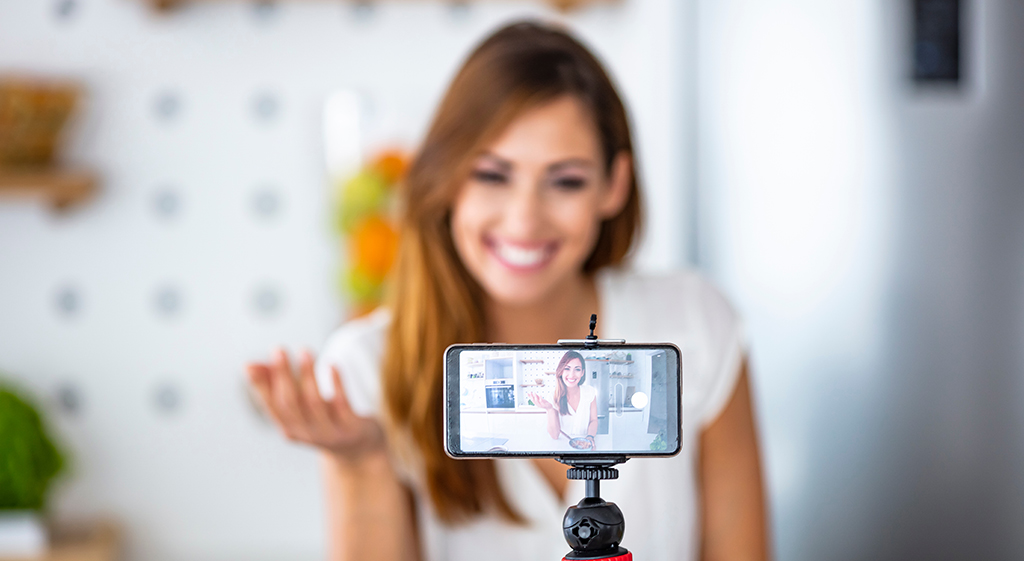
Macro-influencers have become some of the most sought-after creators for brands investing in influencer marketing, and the main reason behind this is, of course, their effectiveness. Working with macro-influencers comes with a number of benefits that can greatly help your brand. Here are some of them.
Let’s start with the more obvious one, the large reach: macro-influencers have a significant following, and because of this large audience, these creators are seen by a considerable number of people. Because of this, macro-influencers are very effective for brand awareness campaigns, as they can put your brand or products in front of hundreds of thousands of people.
Next up are the engagement rates. When compared to smaller influencers, macro-influencers have smaller engagement rates in numbers. However, this is often compensated by the sheer size of their following, as still, a noticeable number of people will be engaging with your brand.
Another important aspect of working with macro-influencers is credibility. As creators working in the industry for some time and having amassed a considerable following, macro-influencers often have established themselves as experts in their niche or industries, which means that their followers trust their recommendations. So, when a macro-influencer promotes your brand, it can help lend considerable credibility to it.
This is not an exhaustive list as working with macro-influencers has many more benefits. However, these three points are some of the most important ones that you need to take into consideration.
Overview of the Typical Characteristics of Macro-Influencers
Apart from their following size, there are a number of other characteristics macro-influencers have you need to know to understand if they will be a good fit for your brand. Let’s take a look at some of them:
-
- Wide reach – as mentioned earlier, wide reach is one of the key benefits of macro-influencers, who can help you get your brand in front of the eyes of hundreds of thousands of people.
-
- Lower engagement rates – These influencers don’t have very high engagement rates, especially when compared to smaller creators who can boast up to 4-7% engagement rates.
-
- Niche-specific – Macro-influencers are quite a niche specific, more or less sticking to the industry they’ve chosen at the beginning of their career.
-
- Professionalism – As creators with years of experience behind their belt, macro-influencers are true professionals, when it comes to brand collaborations and content creation.
-
- Multi-channel presence – Macro influencers are often present on multiple social media platforms, including Instagram, YouTube, TikTok, and Twitter. This allows them to reach a wider audience and build a strong brand presence across different channels.
Macro-Influencer Collaboration Examples
Influencer-brand collaborations often yield impressive and interesting results. Below are a few examples of some of our favorite partnerships between brands and macro-influencers in different niches.
-
- Andry Strong x Vanquish Fitness
Fitness influencer and personal trainer Andry Strong has over the years established himself as a well-known name in the fitness industry, attracting the attention of Vanquish Fitness. He is currently the ambassador of the brand and regularly promotes its products and new collections.
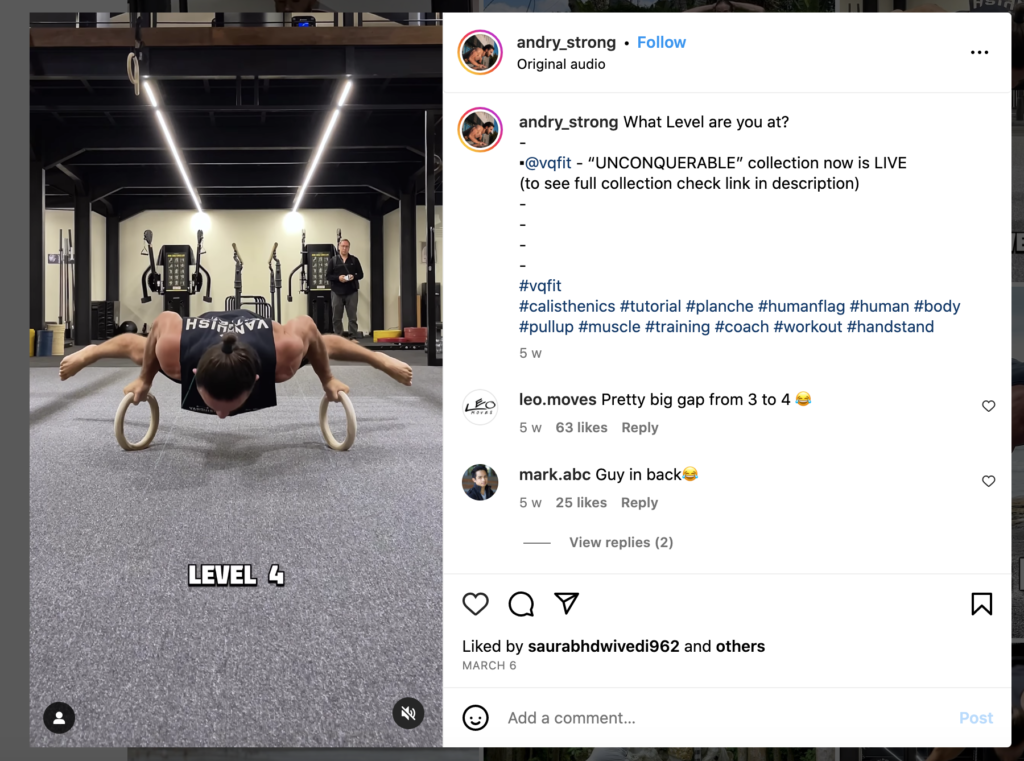
-
- Em Roberts X French Connection US
Fashion influencer and podcaster Em Roberts collaborated with French Connection US, a brand of eco-conscious contemporary clothing to promote several pieces from their new SS 23 collection. In this collaboration, Roberts acted both as an influencer and a UGC creator, as French Connection US posted some of the content on their page as well.
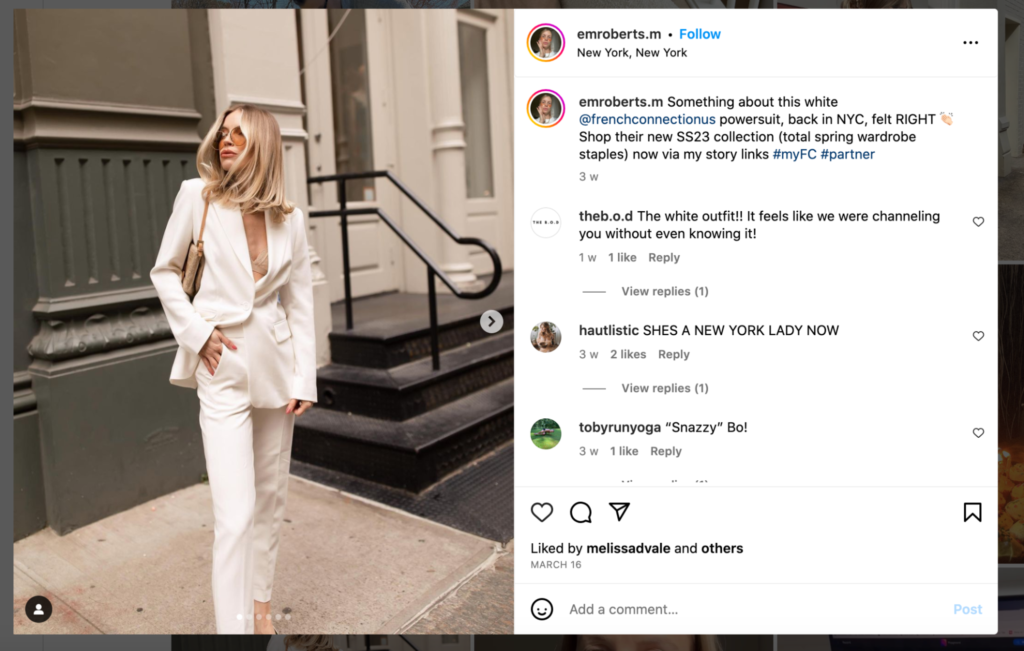
-
- Cynthia Victor x Juvia’s Place
Cynthia Victor, also known by her social media personality Shawtysin is a fashion influencer from Sri Lanka with 280k+ followers on Instagram, who creates different types of videos and posts on Instagram, including #GRWM (Get Ready With Me) video tutorials. One of her collaborations features the make-up brand Juvia’s Place, with which she collaborated to promote some of their products.
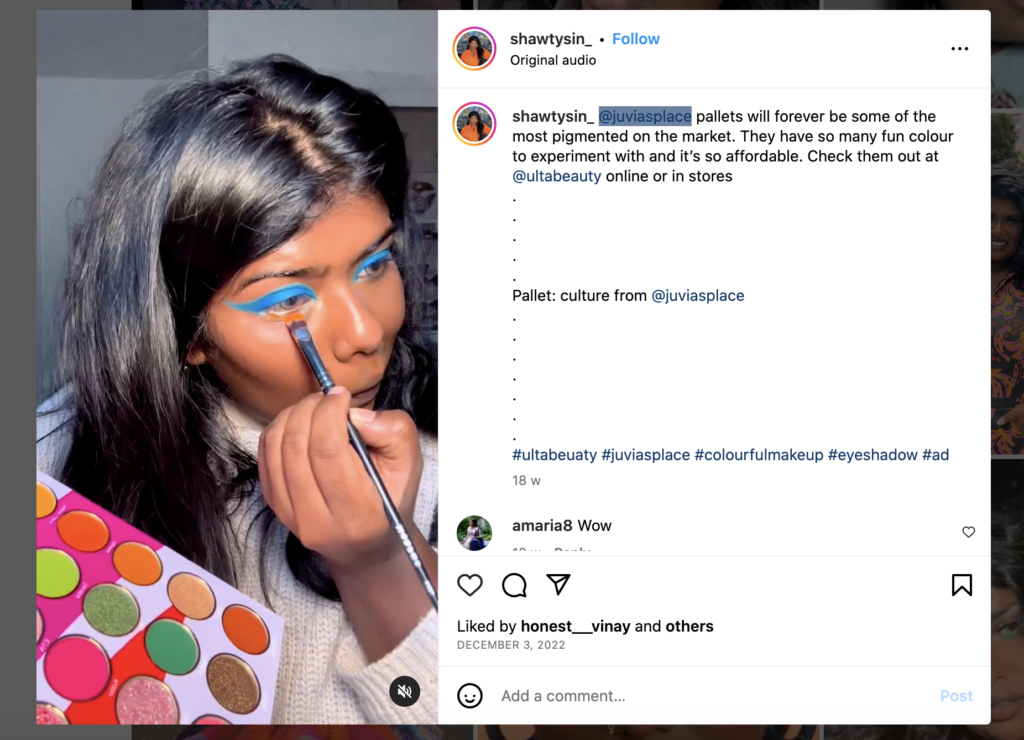
Micro vs. Macro vs. Mega Influencers
As influencer marketing grows, new classifications of influencers emerge depending on their audience size and other characteristics to help marketers which types of creators can help them the most. For brands new to influencer marketing, these classifications may in the beginning seem confusing.
To help you make sense of who’s who in influencer marketing, below are short descriptions of micro-, macro-, and mega-influencers.
Micro-influencers vs. Macro-influencers
Micro-influencers are creators who have a following ranging between 10K-50K. Compared to macro-influencers, they seem to have a relatively smaller following. These creators have often been in the industry for a while now, and although far from being celebrities, have built an audience of dedicated and interested following. As a result, micro-influencers boast high engagement rates, have a very loyal audience, and seem highly authentic.
Between micro- and macro-influencers, the main difference is the audience size, engagement rates, and perception of authenticity. Macro-influencers have a significantly higher reach and are seen by a larger number of people, which makes them a great choice for brand awareness campaigns. Micro-influencers, on the other hand, can be a better choice if you are looking to target a smaller, yet more targeted and engaged audience at a more affordable price.
Mega-influencers vs. Macro-Influencers
In comparison to macro-influencers, mega-influencers already hold celebrity status, and have a following between 1m – 10m. Mega influencers can be social media creators who’ve amassed their following through their content creation efforts, but they also can be famous people who’ve because well-known outside of social media, like actors or musicians. In both cases, these are the people who have been likely doing social media professionally for a few years. Their content reached millions of people, and they can work wonders when it comes to raising brand awareness. However, this comes at the expense of engagement rates, authenticity, and level of targeting.
When compared to macro-influencer, mega-influencers reach significantly more people and have content that looks a lot more professional. However, they don’t have the authenticity and flexibility present in the content of macro-influencers. They are additionally targeting a significantly less niche audience. Lastly, the price point is a major difference between the two, as macro-influencers, although not very startup-friendly, are a lot more affordable.
Working With Macro Influencers: The Drawbacks
Now, working with macro-influencers is a goldmine for brands, but it comes with a few drawbacks too.
Firstly, working with macro-influencers comes at a cost, and that cost can often be quite high. It’d be safe to say that macro-influencers aren’t very startup-friendly when it comes to the pricing. However, this is not set in stone: macro-influencers on the lower end of the follower count can be somehow flexible in terms of pricing, but the creators who have hundreds of thousands of followers will probably charge considerable amounts.
Next up is authenticity. Now, it wouldn’t be an exaggeration to say that authenticity is the cornerstone of the success of influencer marketing in general: people are more likely to be interested in the products if they are recommended by the people, in this case, the creators they know and trust. This is exactly the reason micro- and nano-influencers boast higher engagement rates because they’ve formed friendly and trusting relationships with their followers. In the case of macro-influencers, this atmosphere and trust are often not there to such a high degree anymore, as they are now operating on the professional level.
Lastly, macro-influencers have a less targeted audience. As the following of the creator grows, new people with wide interests join. And while they maintain a more or less defined niche, in the case of macro-influencers it can get broader over time (e.g. fashion influencers can start working with skincare brands). While this further widens the reach, it also makes for the creators and brands harder to target a very narrow niche.
Brand and Macro-Influencer Partnership Strategies
Partnering with macro-influencers can be a powerful way for your brand to reach new audiences and build awareness. However, this can be achieved only if you approach the partnership strategically and carefully planned. For this, here are some strategies that you can consider.
-
- Finding the right influencers – There are many influencers out there, but for your collaboration to succeed, you need to find the right ones. Identify influencers who align with your brand values, target audience, and marketing goals. Look for influencers whose content resonates with your brand, matches your style, and whose followers are most likely to be interested in your products.
-
- Focus on forming long-term partnerships – Building a long-term relationship with an influencer can be more effective than a one-time collaboration. By working with creators over longer periods and in the frames of different campaigns, you can build trust and credibility with their audience, as well as form a deeper collaboration with the influencer themselves, resulting in a more authentic representation of your brand.
-
- Leverage their existing communities – Macro influencers have already built a community of loyal followers. By partnering with them and looking for ways to incentivize their followers, you can tap into that community. Consider offering exclusive promotions or discounts to the creator’s followers to make your brand more appealing to them.
-
- Be clear about your expectations – Lastly, when partnering with influencers, it’s important that you are clear about what you are looking to achieve, whether it’s the content type, the posting timeline, or the final result.
FAQ
Who are macro-influencers?
Macro-influencers are social media creators who have a following between 50k-500k.
Why should brands work with macro-influencers?
As some of the most important creators in the digital world, macro-influencers come with a number of benefits. Brands, that partner with macro-influencers, can expect to reach a large number of people and improve their credibility.
Are there any downsides in working with macro-influencers?
Mega-influencers can work wonders for brand awareness, but there are a number of downsides they come with. Specifically, macro-influencers are significantly more costly than their smaller counterparts, are less flexible in terms of pricing, and may not be a good fit for brands just starting out. Another downside is that while macro-influencers still operate a specific niche, their audience is not hyper-targeted, making it harder for brands to reach exactly the people who’d be interested in their offering.
What is the difference between micro-influencers vs. macro-influencers?
Micro-influencers are creators with 10k-50k followers, while macro-influencers have an audience between 50k-500k. Apart from the follower count, the difference between these two types is that micro-influencers have higher engagement rates and a more targeted and loyal audience, while macro-influencers have a significantly wider reach. In the case of macro-influencers, the targeting is not as hyper-precise, but the lower engagement rates are compensated by the much wider reach.
Conclusion
Influencer marketing is not static, it changes and evolves. Trends come and go, and new categories of creators emerge. However, throughout all these changes macro influencers have shown that they continue to remain relevant in this ever-changing landscape. Because of their unique position and being able to combine the best of both worlds (the authenticity of smaller creators with the wide reach of bigger influencers), macro-influencers are proving to be an effective partner for many brands who are looking to reach new, wider audiences through trusted voices.
Reviewed By Rem Darbinyan
Revolutionizing industries with AI, Rem Darbinyan is the CEO of ViralMango and an entrepreneur, AI expert, and influencer marketing strategist.

